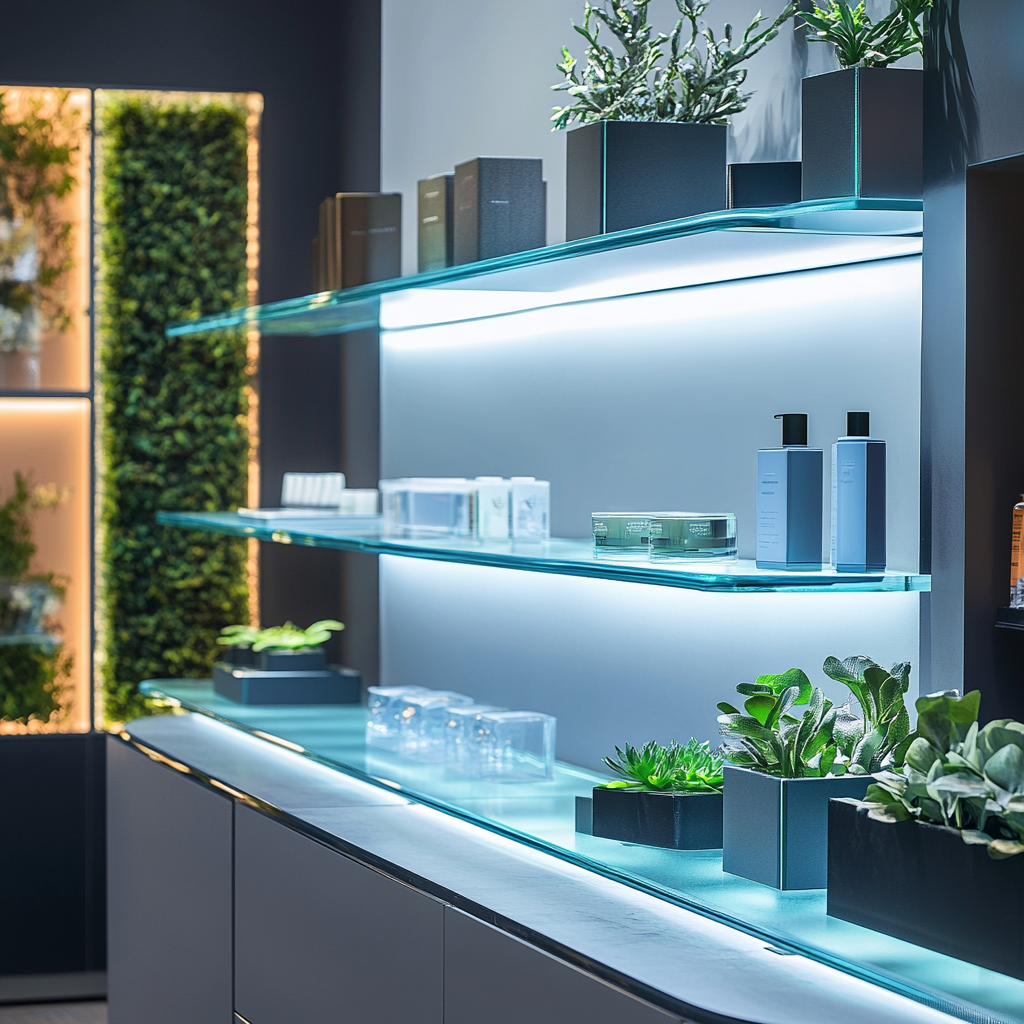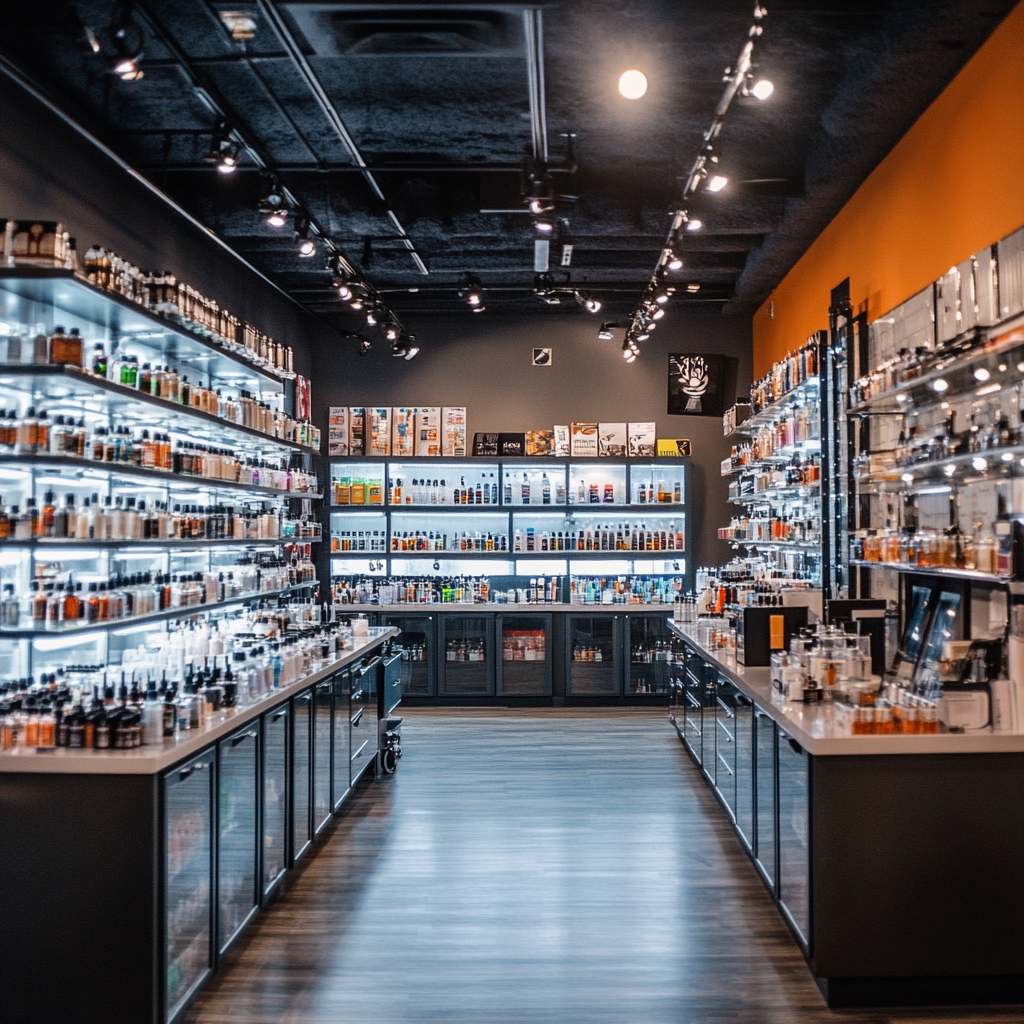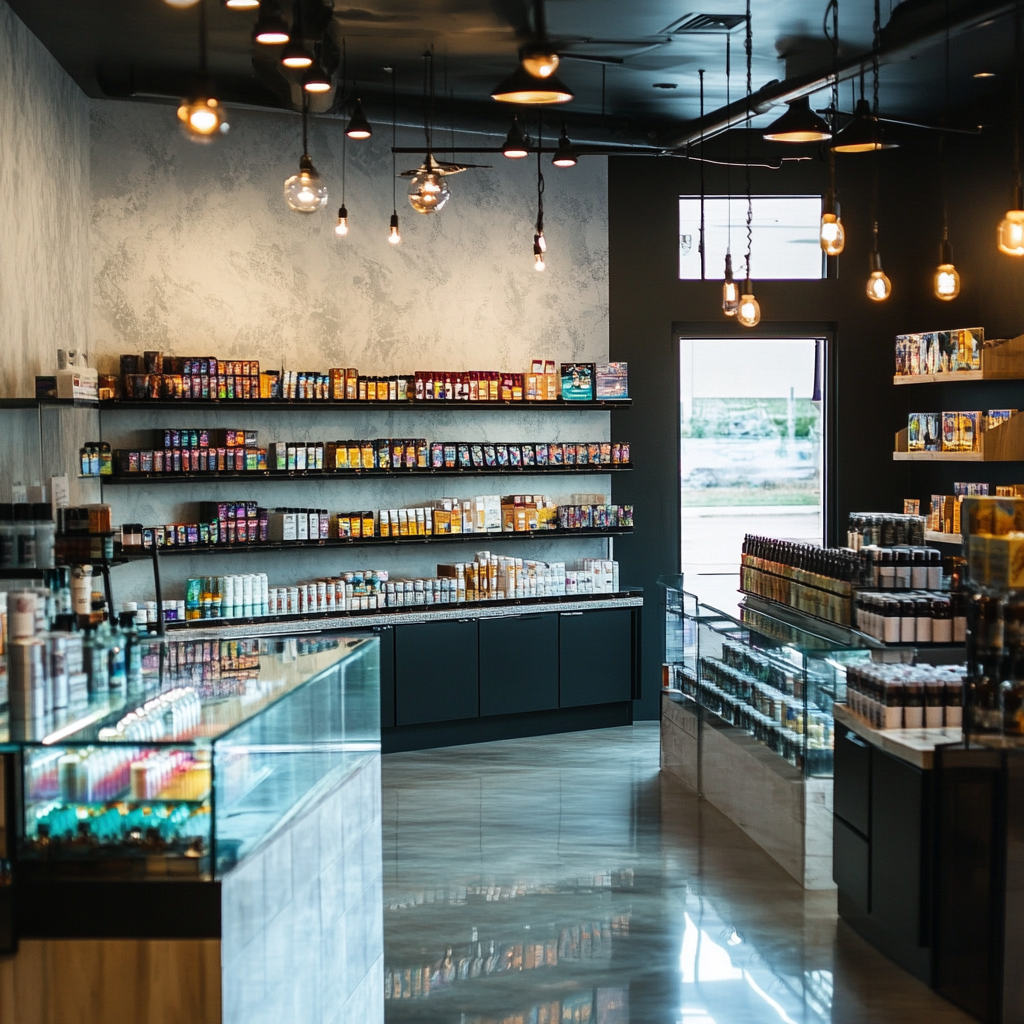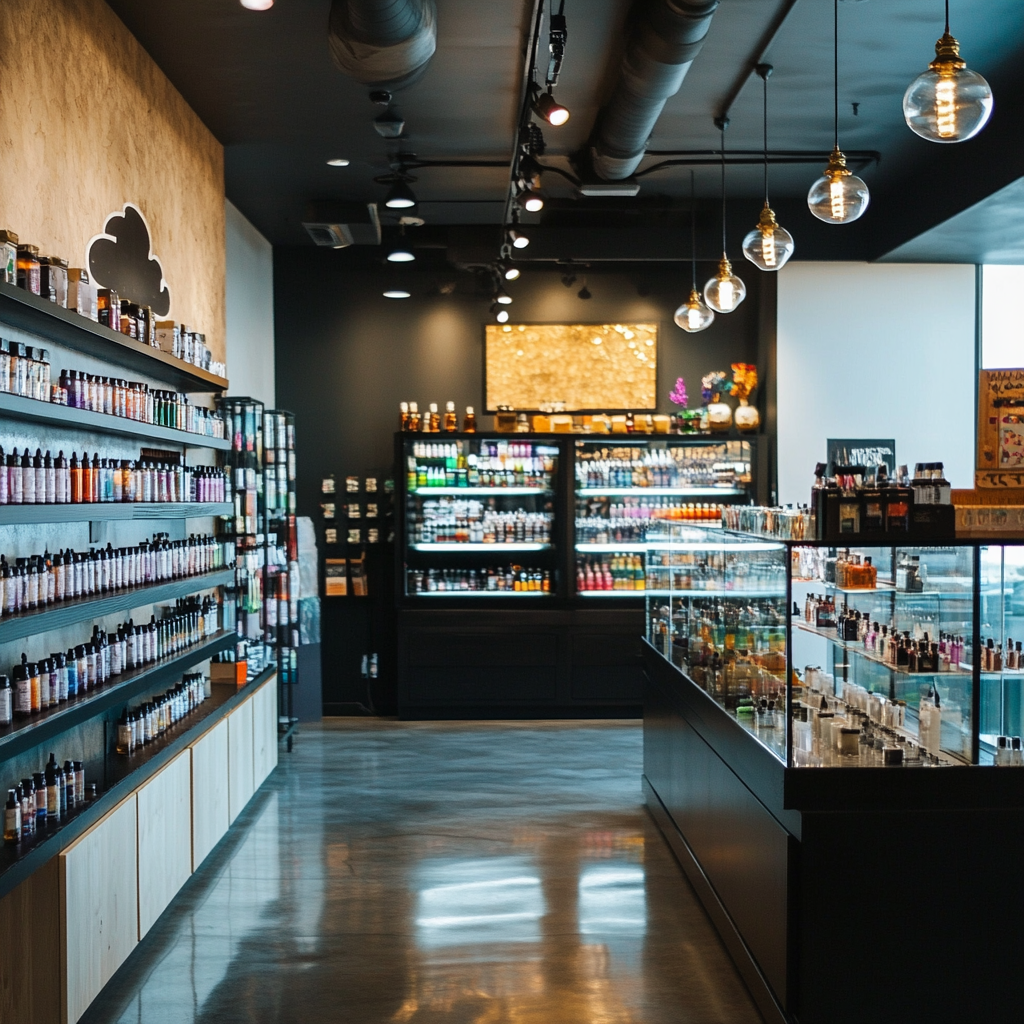As the manager of Fairwill Display, I often hear this question: “Is Owning A Small Business Vape Shop Lucrative?” In my experience, yes—it certainly can be. Vape shops are increasingly popular globally, and store fixtures play a critical role in their success. I’ve provided quality glass showcases to many vape and hookah shops. I’ll share insights from my customers and explain how you can enhance your vape shop’s profitability with suitable displays. Here, we will discover if owning a small business vape shop is lucrative and how quality glass showcases can boost your vape store’s profitability.
Table of Contents
ToggleUnderstanding the Profit Margins in a Vape Shop Business


Exploring Product Categories and Their Markup Potential
Different vape products offer varying levels of profit. E-liquids often have the highest markup. A bottle that costs $5 wholesale can sell for $20 retail. That’s a 300% return. Disposable vapes also bring high margins. They are cheap to source and quick to sell. Customers buy them regularly, ensuring repeat sales.
Hardware such as mods and tanks brings lower margins. These items are durable and not replaced often. Still, they attract passionate users who also buy accessories. Coils and pods fall somewhere in between. They sell fast and carry moderate profit margins.
Accessories like batteries, chargers, and cases generate reliable revenue. They are easy to upsell. You can bundle them with larger purchases. Even smaller items contribute to the overall profit when sold in volume.
Smart shop owners watch inventory carefully. They identify which products offer high margins and turn over quickly. By focusing on those, they maintain a strong profit flow. It’s not just about what you sell, but how often it sells and at what cost.
When planning a product mix, prioritize the high-margin items. Then use lower-margin hardware as a way to drive traffic. Customers will walk in for the devices and leave with accessories and liquids. That balance builds revenue.
Price Strategy and Its Effect on Profit
Setting the right price makes a big difference. Too high, and customers walk away. Too low, and you kill your margin. Finding that sweet spot takes testing and observation.
Most vape shops use a keystone pricing model. This means they double the wholesale price. It keeps prices competitive while protecting margin. But sometimes you can go higher. Limited-edition flavors or popular devices justify premium pricing.
Discounts and promotions help drive traffic but use them wisely. Avoid constant markdowns. They can train your customers to wait for sales. Instead, offer bundles. A pod system with three bottles of juice is attractive and boosts volume.
Upselling helps maximize profit per customer. Train staff to suggest a battery with a mod. Recommend a flavor bundle instead of a single bottle. These tactics raise the average transaction value.
Pricing should reflect local demand. In some areas, premium products are in high demand. In others, affordability matters more. Study your market. Watch competitors. Adjust as needed to stay profitable without losing appeal.
Use clear pricing tags in-store. Customers feel more confident when they know what to expect. Transparency builds trust, and trust leads to repeat business.
Calculating Operating Costs That Affect Margins
Profit isn’t just about sales. Expenses eat into it fast. Rent is a major cost. A central location brings traffic, but also higher prices. If rent exceeds 10% of monthly revenue, it starts to hurt margins.
Utilities add up. Electricity, water, and internet are monthly essentials. Choose energy-efficient lighting and displays to reduce bills. Keep the shop layout practical but attractive.
Staffing is another large cost. Friendly and knowledgeable employees help close sales. But labor costs need to stay within 15%–20% of revenue. Schedule smartly to balance service and efficiency.
Inventory investment ties up cash. If stock sits too long, it loses value. Track sales trends to reorder only what moves. Dead inventory eats profit and shelf space.
Other operating costs include insurance, POS systems, and maintenance. Each one matters. Keep records of every dollar spent. Reviewing them monthly helps you catch waste and adjust spending habits.
A well-managed budget keeps the business healthy. You can earn a strong margin but still lose money if expenses are out of control. It’s vital to track both income and cost.
Profit margins depend not just on high sales but smart spending. Lean operations give you more breathing room and greater profit security.
Using Data to Improve Profit Decisions
Data drives good decisions. POS systems capture every transaction. Use that data to see which items sell well. Identify slow movers too. The goal is to stock high-margin products that customers actually buy.
Daily reports show you the average transaction size. If it’s too low, work on upselling. Staff should know the right questions to ask. “Do you need an extra coil?” or “Want to try our top flavor bundle?” adds dollars to each sale.
Inventory reports are gold. They show turnover rates. Fast turnover means healthy cash flow. Slow-moving items drain capital. Make room for better sellers.
Customer behavior also matters. Track return visits. Repeat customers are more valuable. They spend more and need less convincing. Use loyalty programs to bring them back. Offer a small discount after every five visits. That keeps them loyal and boosts lifetime value.
Online reviews can give clues too. If customers praise your selection or displays, you know what’s working. If they mention high prices, maybe it’s time to adjust. Monitor and act quickly.
Digital marketing metrics also help. Google Ads can show which products or promotions pull the most clicks. Use that info in your physical store too. Align ads and shelf placement for maximum impact.
By using data consistently, you stay ahead. You adjust before problems grow. You invest only in what works. That’s how small vape shop owners stay profitable year after year.
Streamlining Inventory for Higher Margins
Efficient inventory increases your profit margin. Too much stock ties up cash. Too little, and you lose sales. A balanced approach keeps your business running smoothly and profitably.
Use sales data to decide what to restock. Focus on products that sell quickly and carry strong markup. Let go of items that gather dust. Clearance bins help recover some costs from slow sellers.
Shelf space matters. Place your highest-margin items at eye level. Use glass showcases to highlight premium products. These tactics guide customer behavior and improve your profit per square foot.
Avoid chasing trends blindly. Not every new product will perform well. Test in small batches first. Watch how they sell. Then decide whether to invest more.
Seasonal demand affects inventory too. Stock up before the holidays and tax refund season. Reduce inventory in slower months to control overhead.
Build strong relationships with suppliers. Negotiate better pricing when possible. Buying in bulk may reduce per-unit cost, but only if the product sells fast. Otherwise, you’re stuck.
Review inventory weekly. Don’t wait until you’re out of something. Real-time tracking systems help. They alert you to low stock and sales spikes.
A well-managed inventory system saves time and money. It helps you serve customers better. And most importantly, it strengthens your profit margin.
Managing Shrinkage and Loss Prevention
Shrinkage is a silent profit killer. It includes theft, damage, and miscounts. Left unchecked, it can eat into your bottom line fast.
Use display cases to protect valuable items. Glass showcases deter theft and keep things organized. Staff can access products for customers when needed. That adds control.
Train employees to handle merchandise carefully. Damaged goods can’t be sold. Clear procedures reduce mistakes. Good handling saves you from unnecessary losses.
Security systems help too. Cameras placed strategically to act as deterrents. If something goes missing, the footage provides clarity. It’s a small investment that protects profit.
Track inventory regularly. Compare physical stock to your POS records. Even small discrepancies matter. Investigate immediately to stop patterns.
Watch for vendor errors. Sometimes shipments arrive short or damaged. Don’t accept loss. Contact the supplier and request replacements or refunds. Stay assertive.
Limit access to storerooms. Only trusted staff should enter. Too many hands increase risk. Assign responsibilities. That builds accountability.
Loss prevention isn’t just about locking things up. It’s about smart systems and strong team habits. Together, they protect your revenue and maintain your margins.
The Role of Customer Experience in Profit Margins
Happy customers spend more. They return often. They trust your suggestions and follow them. That’s why experience matters so much in retail.
Design your shop for comfort and clarity. Wide aisles. Clean shelves. Good lighting. These details put customers at ease. Comfortable shoppers stay longer and explore more.
Staff should greet every visitor. Offer help, but don’t push. Let them browse. If they ask for advice, be ready. Know your products. Speak clearly and confidently.
Glass showcases add class. They make products feel valuable. When items look premium, customers are willing to pay more. Presentation boosts perception, and perception drives profit.
Play soft music. Offer samples when possible. Small touches make a big impact. They create positive associations. Those moments bring people back.
Always solve problems fast. A defective item? Replace it. A wrong flavor? Fix it. These gestures show integrity. Customers talk about good service. Word of mouth brings new traffic, and new traffic means more revenue.
Customer experience isn’t a luxury. It’s a profit strategy. Get it right, and margins rise naturally.
Analyzing Real-World Vape Shop Case Studies
Let’s look at real examples. In New York, a small vape shop in Brooklyn grew fast by focusing on premium juice and strong service. Their margin hit 70% in the first year. They used display cases to create a high-end feel, attracting upscale buyers.
In California, another store emphasized affordability. They offered budget bundles and daily promotions. While their margins were lower per item, their volume was high. That balanced their earnings and kept revenue steady.
One store in Sweden partnered with local suppliers. They reduced shipping costs and improved inventory flow. They focused on selling what their customers wanted most. Their average margin increased 15% after six months.
Common threads include smart inventory, good displays, and clear pricing. None of them relied on luck. Each one watched data, served customers well, and controlled cost.
These stories prove that vape shops can be profitable. With the right systems and mindset, strong margins are within reach.
Startup Costs and Investment for a Small Vape Shop


Starting a vape shop sounds exciting, but how much money do you need upfront? The answer depends on many factors. These include location, store size, product range, and the quality of your displays. To understand is owning a small business vape shop lucrative, you first need to evaluate the investment needed to open the doors.
Let’s break down the essential startup costs for a vape shop. This will give you a realistic view of what to expect and how to plan your budget wisely.
Rent and Lease Deposits
Location plays a big part in your monthly rent. If you’re opening in a busy commercial area, expect to pay more. A small vape shop usually needs between 500 to 1,000 square feet. Rental prices differ from city to city. In some U.S. areas, rent can range from $1,000 to $5,000 per month.
You also need to pay a lease deposit. Most landlords ask for the first month’s rent and a security deposit. This initial outlay could total $3,000 to $10,000 depending on your agreement. It’s a big chunk of your startup budget, and planning ahead is vital.
A cheaper location may lower rent but could affect your sales volume. You must balance cost with visibility. A vape shop in a high-traffic area tends to attract more customers, which makes the higher rent worthwhile. Think of rent as an investment in future profits.
You might also need to spend on permits or zoning approvals. These costs vary based on local regulations. But they often come with the lease process. Always research local laws before signing anything.
After rent and deposits, you still have a long list of startup costs to manage. Let’s look at the next major one—store renovation and fixtures.
Interior Renovation and Fixtures
When asking if owning a small business vape shop lucrative, one must consider the interior setup. A well-designed shop creates a better customer experience. You can’t skip this step. Even if the space looks okay, you may still need changes.
The walls may need paint. Floors may need repairs. Electrical systems may require upgrades. The lighting should be warm and inviting. Customers feel more confident buying in a clean, stylish, and organized store.
Interior renovation costs can range from $2,000 to $10,000. It depends on the condition of the space. Some shop owners go for minimal designs. Others invest in detailed interiors. Either way, your shop must look professional.
Next, come the fixtures—glass showcases, slatwall panels, and shelving. These make your products more visible and appealing. A standard vape shop needs multiple display counters. You may also want countertop trays for small items and acrylic stands for e-liquids.
At Fairwill Display, we often help vape shop owners choose cost-effective fixtures. A full set of high-quality glass showcases, made from E1-grade boards and tempered glass, may cost $2,000 to $5,000. It depends on your layout and product volume.
Fixtures are not just for decoration. They affect your sales. Organized displays help customers find what they need. They also allow you to highlight bestsellers and new arrivals.
Once you’ve taken care of the interior, you’ll need to stock your store with inventory. That’s another major cost.
Inventory Investment
No shop can operate without products. Inventory is one of the largest startup costs. It’s also the most sensitive. Buy too little, and you lose sales. Buy too much, and you risk wasting or overstocking.
A typical starter inventory for a small vape shop costs $10,000 to $25,000. This includes disposable vapes, vape pens, e-liquids, coils, and accessories. The cost varies based on your brand selection, variety, and volume.
Diversifying your inventory is essential. Some customers want budget options. Others prefer premium products. You’ll need both. Include different nicotine strengths and flavor types. A diverse range appeals to more buyers.
Always monitor your sales trends. Restock items that sell fast. Reduce orders for slow movers. Many suppliers offer wholesale discounts. Take advantage of these when you can.
To lower your risk, start small. Track what sells in your first few months. Adjust your next order accordingly. You may even negotiate with suppliers for better terms or smaller minimum orders. That way, your inventory costs stay manageable.
You’ll also need storage space for inventory. Keep your backroom organized and safe. Invest in racks and bins. Avoid mixing old and new stock. Freshness matters, especially for e-liquids. After inventory, there’s another key area—staffing and daily operations.
Staffing and Daily Operations
Even a small vape shop can’t run on its own. You need people to serve customers, track sales, and manage the store. If you work alone, you save money. But long hours can lead to burnout. Hiring part-time help may improve customer service and let you focus on growth.
Typical wages for vape shop staff range from $12 to $18 per hour. Hiring two part-time employees may cost $2,000 to $3,000 per month. This number depends on your opening hours and how busy the shop gets.
Don’t forget other daily operational costs. These include utilities like electricity, internet, and water. You’ll also need point-of-sale software, a cash register, and maybe a computer. These add another $1,000 to $3,000 to your initial spend.
Marketing is also crucial. You must attract customers to your new vape shop. Invest in signage, flyers, and online ads. A basic marketing budget may start at $500 to $2,000. If you promote through Google, you can reach more local buyers quickly.
Insurance is another requirement. Business insurance protects you from unexpected events like theft, accidents, or damage. Expect to pay $500 to $1,500 per year for basic coverage. It’s a small price for peace of mind.
Licensing is non-negotiable. Most regions require a tobacco or vape retail license. Costs vary by state or country but can range from $300 to $2,000. Failing to comply leads to fines or shutdowns. Always double-check local regulations.
After handling your daily costs, you’ll want to consider how to protect your investment and grow profits. Let’s explore this in the next part.
Planning for Break-Even and ROI
Understanding the path to profitability is vital when deciding if owning a small business vape shop lucrative. You’ve already made the initial investment. Now, how long before you earn it back?
Break-even means covering your startup costs with your shop’s revenue. A realistic goal is 6 to 12 months. Some vape shops break even faster, depending on traffic and demand. Others take longer, especially if they open in slow seasons.
Here’s an example. If your startup investment totals $40,000, you’ll need monthly profits of $3,500 to break even in a year. That includes net profits after expenses. This is why smart inventory choices and cost-effective displays matter.
Profitability grows as you build regular customers. Vapers tend to make frequent purchases. That helps you generate steady revenue. It also supports your ROI—return on investment.
Boosting ROI means cutting waste and improving margins. Buying wholesale, choosing quality display fixtures, and reducing rent costs are effective ways. Also, upselling and bundling products increase basket size.
Once you’ve broken even, your revenue becomes real profit. From there, you can reinvest in marketing or upgrade your store design. You can even open a second location.
Profitability also depends on how well you manage your money. Keep detailed records of all expenses. Monitor your income weekly. Adjust your strategy if sales dip or costs rise.
Many new owners forget to pay themselves. Factor your salary into your business plan. This makes your profit goals more accurate.
After setting your financial foundation, you’ll be better prepared for growth. Let’s now consider long-term cost control.
Managing Costs Over Time
Owning a vape shop isn’t just about the launch. Long-term cost control determines how lucrative the business is. Startup costs are high, but operating smartly keeps expenses down.
Begin by reviewing your monthly bills. Find areas where you can save. Switch to energy-efficient lighting. Negotiate rent renewals. Reorder stock based on real demand—not guesses.
Don’t overlook your suppliers. Build strong relationships. Loyal customers often get better deals. Ask for promotions or seasonal discounts. Order in bulk when it makes sense. But avoid overstocking.
Maintenance costs come up as your store gets older. Fixtures may need repairs. The walls may need repainting. Budget a small monthly reserve—perhaps 5% of your sales—for maintenance.
Train your staff to reduce loss. Lost or stolen products hurt your profit. Implement a daily inventory check. Use a reliable POS system. Teach staff to monitor suspicious behavior.
Monitor advertising efficiency. If your Google Ads aren’t converting, adjust the keywords or landing pages. Track which promotions bring the best return. Focus your spending on proven tactics.
Stay updated on laws and taxes. Vape regulations change often. New taxes can affect prices. Plan for compliance. This avoids fines and keeps your store open.
Keeping costs low is key to long-term success. It allows you to weather slow months and reinvest during good ones. The lower your expenses, the more profit you keep.
Final Thoughts: Is Owning A Small Business Vape Shop Lucrative?
The answer is yes—but only with careful planning and cost control. Initial investment ranges from $30,000 to $60,000 for most small vape shops. The key expenses include rent, fixtures, inventory, staffing, and licenses.
The good news is that vape shops benefit from repeat buyers. Many customers return weekly. This builds stable revenue. With smart displays like glass showcases, products stand out and sell better. That’s why choosing the right fixtures matters so much.
At Fairwill Display, we help new shop owners invest wisely in in-store setups. Our glass showcases offer excellent quality at a low cost. Using E1-grade boards and tempered glass ensures safety, durability, and appeal. These fixtures last years, making them a strong investment.
If you manage your shop well, watch expenses, and engage your community, you’ll see profits. In that case, owning a vape shop becomes not only sustainable—but highly rewarding. So, is owning a small business vape shop lucrative? It absolutely can be—with the right start.
Location Matters: Choosing Where to Open Your Vape Shop


When starting a vape shop, one of the biggest decisions is where to open it. Many new business owners underestimate this part. But your location shapes everything—your rent, your customers, your foot traffic, and ultimately your profit. If you want to know, if owning a small business vape shop lucrative, then location must be part of your answer.
In this section, I’ll walk you through how to choose the right location. I’ll cover demographics, visibility, rent, competition, and long-term growth. Let’s dive into each area and see how it connects to your vape shop’s future.
Understanding Your Local Demographics
Your store’s success depends on who lives nearby. If the people in your area don’t vape, you won’t make many sales. That’s why it’s critical to know your local demographics before opening your store. You must understand your ideal customer.
Start by asking: who is your main audience? Most vape users are between the ages of 21 and 40. They are young adults, college students, or professionals. These customers are often trend-conscious and tech-savvy. Many are switching from cigarettes. Others are vaping for flavor or lifestyle.
Choose an area where this age group lives, works, or hangs out. Look for college towns, creative districts, or busy downtown zones. These places have high concentrations of your target customers. The more people in your ideal age range, the higher your chances of success.
Income levels also matter. If the local population has stable jobs or disposable income, they’re more likely to spend on vape products. Some may go for premium devices, while others want budget options. Offer both. Flexibility helps serve a wider range of customers.
Research is key. Use public data to check income, age, and lifestyle trends in different neighborhoods. Visit local forums, talk to other store owners, or survey the streets yourself. This groundwork pays off.
When asking, if owning a small business vape shop lucrative, remember that your customer base decides your sales ceiling. The wrong audience means wasted rent, wasted time, and zero profits.
Evaluating Visibility and Foot Traffic
Once you’ve chosen the right demographic area, you must focus on visibility. A hidden store doesn’t get walk-ins. And no walk-ins mean slow business. Your location must be easy to find and inviting to enter.
Start by checking street-level exposure. Is the shop located on a busy road? Can drivers and pedestrians easily spot it? How close is it to traffic lights, bus stops, or intersections? More exposure means more curiosity—and more sales.
Foot traffic is another big factor. People need to walk by your store to come inside. You should be near places that generate steady foot traffic, like coffee shops, gyms, supermarkets, or convenience stores. These places attract the same audience as vape shops.
Don’t just count people—watch how they move. Do they walk fast or linger? Are they browsing nearby stores or rushing to work? You want relaxed foot traffic. People who have time to stop and look around are more likely to enter your shop.
Your storefront also matters. It should be clean, modern, and bright. Use large windows and attractive signage. Display your products clearly. At Fairwill Display, we provide glass showcases that help owners create eye-catching window setups. These displays turn curious passersby into paying customers.
If your shop is hidden in a back alley or upper floor, you’ll rely heavily on online marketing. That adds extra costs. A high-visibility location reduces the need for constant ads. It brings customers in naturally.
To increase your chances of answering yes to owning a small business vape shop, make sure your store can be seen—and reached—easily.
Analyzing Rent and Lease Costs
Once you’ve found areas with strong demographics and visibility, it’s time to look at rent. Monthly rent is one of your biggest ongoing costs. Too high, and your profits shrink. Too low, and the area might lack foot traffic or safety.
Start by comparing prices in different neighborhoods. Urban areas charge more but offer better visibility. Suburbs cost less but may lack your target audience. A balance is ideal. Aim for a space that offers decent exposure without draining your budget.
Expect rent to range from $1,000 to $5,000 per month for small vape shops, depending on the city. You’ll also need to pay deposits and possibly property taxes or shared fees. Read every lease term carefully. Some landlords include utilities, while others don’t. Clarify before signing anything.
Negotiate lease terms when possible. Ask for reduced rent during the first three months while you set up. Try to secure a multi-year lease with fixed rent. This gives you financial stability. Avoid short leases that might force you to relocate just as business picks up.
Also, consider your unit’s size and layout. A 600 to 1,000-square-foot space works well for a vape shop. It’s enough for display counters, a small office, and some storage. Bigger isn’t always better. Every extra square foot adds to your rent and energy bill.
Overpaying for rent can break your budget. However choosing a cheap location with poor traffic can kill your business. Your goal is to find the sweet spot—affordable rent in a visible, busy area with the right customers nearby.
That’s the type of location that makes the answer to owning a small business vape shop lucrative a strong yes.
Assessing Local Competition
Every business has competition. In the vape world, it’s no different. Before opening your shop, you need to know who else is in your area. This doesn’t mean you should avoid all competition. It just means you need to understand the landscape.
Start by searching online. Use Google Maps to locate nearby vape shops. Visit them in person. What brands do they sell? How’s their customer service? What does their store look like? Take notes on what they do well—and where they fall short.
If a neighborhood already has five vape shops within two blocks, it may be saturated. But if the nearest competitor is far away—or lacks good displays or service—you may have a chance to win that market.
Pay attention to niche gaps. Other stores might not offer disposable vapes, have high prices, or carry only one or two e-liquid brands. You can fill these gaps by offering more variety, better pricing, or a cleaner layout.
At Fairwill Display, we often hear from clients who outperformed their competitors simply by improving their visual merchandising. Glass showcases, LED-lit shelves, and custom counter displays make a huge difference. Customers want to see products. If your store layout is better, you win more sales—even in competitive areas.
Another trick is to differentiate your store. Add a small vape lounge. Offer loyalty programs. Host flavor tasting events. These experiences create stronger customer connections.
Knowing your competition helps you plan your pricing, product range, and design. It also gives you confidence. If you know what others offer, you can offer more—or better. That’s how you make owning a small business vape shop lucrative in any market.
Factoring in Zoning and Legal Permissions
Not every space is legally allowed to house a vape shop. That’s why you must research zoning laws before signing a lease. Local governments regulate where vape stores can operate.
In some cities, vape shops must be a certain distance from schools, parks, or churches. Other places restrict how close you can be to another tobacco or vape business. Violating these rules can lead to fines or forced closure.
Go to your local business development office or zoning department. Ask for maps or documents showing which zones allow vape retail. Some cities even post this online.
Next, apply for the necessary permits. You may need a general business license, a tobacco license, and a vape retailer permit. The process varies by city or country. In the U.S., for example, state and federal rules both apply.
Zoning issues can delay your opening. If you sign a lease without checking first, you risk losing your deposit. Always verify before committing.
Choosing a legally compliant location saves time and money. It protects your investment. It also ensures that when someone asks, if owning a small business vape shop is lucrative, you don’t answer with, “Well, it would have been—if I could open.”
Considering Future Growth and Expansion
When choosing your location, think beyond the first year. What happens if your shop becomes popular? Will you have room to grow? Can you expand your product range or create a lounge space? Is there storage space for more inventory?
Look at the neighborhood’s long-term prospects. Are new apartments being built? Are tech companies moving in? Growth in the area means growth for your shop. A once-quiet corner could turn into a hotspot within two years.
Also, consider nearby real estate options. If your business expands, you may want to rent a second unit, a warehouse, or a pop-up kiosk. Staying in the same area helps keep your customer base.
Some shop owners regret opening in low-growth zones. As nearby businesses shut down, their customer numbers fall. Don’t fall into that trap. Choose a neighborhood with strong long-term value.
If you plan well, your shop’s location won’t just support your business—it will elevate it. Customers will find you, trust you, and return again and again. That’s how you answer yes to owning a small business vape shop lucrative—with real results.
Balancing Budget and Opportunity
Every location comes with trade-offs. A high-traffic mall costs more but delivers ready-made traffic. A quiet street is cheaper but requires more marketing. You must balance your startup budget with the opportunities each location offers.
Make a list of non-negotiables. Do you need parking? Do you want ground-floor access? Must you be near certain landmarks? Then make a second list—nice-to-haves. These might include patio space, a loading dock, or a flexible lease.
Once you know what matters most, you’ll evaluate spaces more easily. Visit multiple properties. Compare them side by side. Bring a tape measure. Take photos. Visualize where your counters and showcases will go.
Sometimes, a location with slightly higher rent offers greater value. If it saves you $500 per month in ads—or brings in 100 more customers—it’s worth it. Don’t just look at the cost. Look at value. Look at the potential.
A smart location gives you a head start. It brings people to your door. With strong displays and a good layout, you turn those people into buyers. That’s how you turn the question, is owning a small business vape shop lucrative, into a confident yes.
Legal and Regulatory Challenges in the Vape Industry


Every vape shop owner must follow the law. This isn’t optional. The rules are strict, especially in the vaping world. Governments want to protect consumers, prevent underage use, and control product safety. If you don’t comply, you’ll face fines, closures, or worse. You must stay informed to protect your business.
So, when someone asks me, is owning a small business vape shop lucrative, I say this—it can be. But only if you manage the legal risks properly.
This section dives deep into four major areas: federal laws, local and state regulations, age restrictions, and packaging or labeling rules. Understanding these legal pillars helps you operate safely and profitably.
Understanding Federal Laws and Compliance Requirements
Let’s start with the big picture. In countries like the United States, federal laws shape how vape shops operate. These rules come from government agencies like the FDA (Food and Drug Administration).Customers seek advice on which coil fits their device, inquire about nicotine levels, and request assistance with transitioning from smoking.
That includes e-liquids, vape pens, disposables, and even some accessories. Since 2016, vape businesses must follow strict rules under the “Deeming Rule.”
First, all vape products must go through a process called PMTA (Premarket Tobacco Product Application). This process proves that your products are safe and meet quality standards. If your products aren’t FDA-approved, you can’t sell them. Many small manufacturers struggle with this, but retailers must check if their products are compliant.
Next comes registration. If you mix your e-liquids or repackage them, you may be considered a manufacturer. That means more rules apply. You’ll need to register your facility with the FDA and submit ingredient listings and manufacturing processes.
Federal inspections are possible. If inspectors visit, you must provide documentation to prove compliance. This includes purchase records, invoices, and certificates of analysis for your products.
Ignoring federal rules can destroy your business. Authorities may issue warning letters, remove your products, or issue large fines. Some shop owners get caught because they don’t know the law. But ignorance doesn’t protect you.
To run a profitable and lawful vape shop, you must choose compliant suppliers. Ask for FDA registration info. Request test results for e-liquids. Confirm that labeling meets legal standards. Keeping your shop legal makes it easier to succeed long-term.
Navigating Local and State-Level Regulations
Federal law is only part of the challenge. You also need to follow your local and state rules. These vary widely depending on where your vape shop is located. Some cities are vape-friendly. Others are not. Some allow flavors. Others ban them. You must research carefully.
Start with your state or province. In the U.S., for example, each state can set its own tax rates on vape products. Some have excise taxes—others don’t. These taxes affect your pricing and profit margins. You must factor them into your business plan.
Licensing is also handled at the state level. Most states require a vape retailer license. Some require separate licenses for nicotine and non-nicotine products. You may also need a tobacco reseller license. Each license has a cost and renewal process. Missing a renewal deadline can lead to penalties.
Cities and counties may add more rules. Customers inquire about which coil fits and ask about nicotine levels, while also seeking assistance in switching from smoking. These restrictions affect how you attract customers.
If your store is in a shopping plaza, the landlord may have policies about what you can sell. Some shopping centers ban vape stores altogether. Always check lease terms before signing.
To stay compliant, contact your local chamber of commerce or small business office. Ask for a list of required licenses and rules. Also, attend city council meetings or read news updates. Local laws can change fast, and you must stay ahead.
When someone asks, if owning a small business vape shop lucrative, I always say—yes, but only in the right city, with the right paperwork. Location and compliance go hand in hand.
Enforcing Age Restrictions and Verifying Customers
Selling vape products to minors is strictly forbidden. This rule applies worldwide. In the U.S., the legal age to buy vaping products is 21. In most European countries, it’s 18. Selling to underage buyers will destroy your business fast.
Governments do undercover tests. They send minors to vape shops to try to buy products. If you sell to them, you get a fine—or worse, your license gets revoked. Some shops fail these tests simply because staff didn’t ask for ID. That mistake costs thousands of dollars.
You must enforce age verification for every sale. This applies in-store and online. In-store, you should check ID for anyone who looks under 30. Use a scanner or manual check system. Don’t guess someone’s age. It’s not worth the risk.
Online stores need third-party verification tools. These systems check age using databases or ID uploads. Some countries now require government-approved age check tools. If you skip this step, your site could get blocked or your domain banned.
Also, train your staff. Every employee should know how to verify ID, what forms of ID are acceptable, and how to deny a sale politely. Post signs clearly stating your age policy. That way, customers know the rules.
At Fairwill Display, we work with vape shop owners worldwide. Many of them tell us how age compliance saved them from legal trouble. Having strong systems in place gives you peace of mind. It protects your reputation.
So, is owning a small business vape shop lucrative? Only if you protect your license. Selling to minors is the fastest way to lose everything. Enforce age rules every day, with every customer.
Meeting Packaging and Labeling Standards
Even if your products are legal and your customers are of age, you still need to meet packaging laws. This area is easy to overlook—but critical. If your products don’t have proper labels, you can be fined or forced to pull them from your shelves.
Start with basic label elements. Most countries require:
- Ingredient lists
- Nicotine content
- Health warnings
- Manufacturer contact information
- Batch numbers or tracking codes
- Expiration dates (for e-liquids)
Some jurisdictions require exact font sizes, color contrasts, and placement of the warnings. Others ban packaging that looks appealing to children. That means no cartoons, flashy colors, or candy-like designs. If your products violate this, regulators will see it as targeting minors.
Child-resistant packaging is also required. This means twist caps, locking lids, or press-to-open bottles. These features prevent accidents and protect public safety.
Retailers must also follow display laws. In some regions, vape products must be kept behind the counter. In others, they can’t be placed near candy or snacks. These laws change quickly, so you must stay updated.
At Fairwill Display, we help clients organize their glass showcases in a compliant way. We make sure shops don’t place vape pens next to candy trays. We help with custom dividers, trays, and secure display cases. That way, store owners avoid display violations.
Labeling laws also affect marketing. Some countries ban claims like “safe” or “healthier than smoking.” Others restrict flavor names. Make sure your supplier follows these rules. If they don’t, you’re the one who pays the price.
Proper labeling protects you and your customers. It builds trust. It also ensures that your products won’t get flagged or banned during inspections.
When someone wonders, if owning a small business vape shop lucrative, the answer is yes—but only when your products are labeled and displayed by the book.
Staying Up-to-Date With Legal Changes
One of the hardest parts of the vape industry is change. Laws evolve. What’s legal today may be banned next year. That’s why smart shop owners stay informed. You can’t afford surprises.
Join local vape retailer associations. These groups track law changes and provide legal updates. Follow newsletters from your local health department or small business office. Read trade publications. Attend industry events or webinars. These resources help you stay current.
Also, build a relationship with a legal advisor. If you can’t afford one full-time, hire someone for occasional reviews. They can check your licenses, inspect your labels, or help you respond to warning letters.
Keep digital and paper copies of all licenses and certifications. Store supplier invoices and compliance papers. If inspectors come, you must show proof quickly. Staying organized protects your shop during audits.
The best vape shop owners act before the law changes. They adjust displays, replace products, or update labels before being told. That’s how they stay ahead of the game.
Owning a vape shop can be profitable, but only if you stay within the rules. When you follow the law, you build a business that lasts. So again, is owning a small business vape shop lucrative? Absolutely—but only for those who follow the legal path carefully.
Customer Trends and Market Growth in the Vape Industry


To answer the question “Is owning a small business vape shop lucrative?”, I need to look at the market. Who are the customers? What do they want? Is the demand growing? These answers shape your sales, your inventory, and your store’s future.
In this section, I’ll cover four key areas: customer demographics, consumer behavior, product demand trends, and global market expansion. Understanding these trends will help you attract the right customers and increase profits.
Who’s Buying Vape Products Today?
Vape customers come from all backgrounds. But most of them fall into clear age and lifestyle categories. Knowing who they are helps you stock the right products and choose the right marketing.
Most vape users are aged between 21 and 40. Many are former smokers. They want a less harmful option. Others are lifestyle users who enjoy the flavors and culture. These customers visit vape shops weekly or even daily. That’s good news for business.
Younger adults, especially in urban areas, form the core of the vape audience. They look for sleek devices, strong flavors, and reliable brands. They care about value, but also style and quality.
Men make up a larger share of vape users. But women are catching up fast. In some regions, female users prefer discreet devices or fruit-based flavors. Including products that appeal to both genders helps grow your base.
Many vapers enjoy talking about their experience. They follow vape influencers online, join social media groups and often post reviews or unboxing videos. That makes them ideal for word-of-mouth marketing.
The income range is broad. Some customers want cheap disposables. Others buy premium box mods and expensive e-liquids. Stocking a mix of price points lets you serve both markets.
Finally, people care about trust. They want clean, legal, and clearly labeled products. If they like your shop, they return. That repeat business builds your revenue over time.
If you can match what customers want, then yes—owning a small business vape shop is lucrative. But you must keep up with how those wants evolve.
How Vape Customers Are Shopping
Shopping habits have changed. Many people still visit vape shops in person. But online sales have grown too. If you understand how people shop, you’ll build a better store.
In-store customers want to see and touch products. They ask questions. They want to smell the flavors. That’s why store design matters. You must guide their journey from the front door to checkout.
Glass showcases display counters, and well-lit shelves help. They make products look clean and organized. At Fairwill Display, we create layouts that make stores easier to shop. This improves conversion rates.
Impulse buys are common in vape shops. Customers often add an extra e-liquid or disposable at checkout. That’s why you should place small items near the register. Use trays or acrylic bins to catch their attention.
Many customers also expect knowledgeable staff. They ask for advice on nicotine levels, coil changes, or flavor pairings. Staff training helps turn questions into sales.
Online shoppers care about speed and trust. They want a fast site, clear photos, and age verification. Offering delivery or click-and-collect increases loyalty.
Some customers browse online and then buy in-store. Others do the reverse. Your website must match your store’s style. Use the same colors, product names, and images.
Loyalty matters. Many vape users buy the same products again and again. Use loyalty cards or points programs. Offer deals for repeat buyers. These systems keep them coming back.
Customers want ease, style, and service. Give them all three, and they won’t shop anywhere else. That’s how you boost profit—and make owning a small business vape shop lucrative long term.
What Vape Products Are in Demand?
Product trends shift fast in this industry. What’s hot one year might fade the next. Knowing what sells now helps you stay ahead.
Right now, disposables are booming. They’re cheap, easy to use, and require no maintenance. New flavors launch every month. Some customers buy multiple units per visit. That’s great for sales.
Pod systems also perform well. These are refillable but still compact. Brands like JUUL or RELX lead this space. Customers like the mix of convenience and customization.
For experienced users, box mods remain popular. These offer bigger clouds and more control. These users also buy coils, batteries, and tanks. That boosts your upsell potential.
E-liquids are your biggest long-term sellers. They bring repeat customers. People always need refills. Offer different nicotine levels and base blends. Include options for salt nicotine and freebase formulas.
Flavor trends vary by region. Fruit and dessert flavors lead in many countries. Menthol and mint also do well. In some areas, local tastes like tea or spice flavors gain ground.
Nicotine-free products are growing too. Some users enjoy the experience but want to avoid nicotine. Stock a few zero-nic options for them.
CBD and alternative products are another trend. Many shops now offer CBD vapes or oils. Others include Delta-8 or herbal blends. These products carry extra-legal rules but bring new buyers.
Stocking the right mix boosts your basket size. A customer may come for one item but leave with three. Use bundles or promotions to encourage this behavior.
Always ask suppliers for trend updates. Attend trade shows if possible. New product lines often start there. Staying current keeps you ahead—and makes your shop more profitable.
The products you offer decide your profit margin. And if you stock wisely, the answer to is owning a small business vape shop lucrative becomes clearer.
Where the Vape Industry Is Headed
Vaping is no longer a niche market. It’s global. And it’s growing. Understanding the big picture helps you build a long-term plan.
In the U.S., the vape market is worth billions. Growth slowed during the pandemic but has rebounded. Younger users and ex-smokers drive much of this demand. Disposable sales have surged in recent years.
Europe follows a similar trend. Countries like the U.K., Germany, and France have strong vape cultures. TPD regulations shape product packaging, but demand remains high. Vapers in Europe prefer sleek designs and smooth e-liquids.
Asia is catching up fast. China, South Korea, and Malaysia have booming vape markets. Regulations vary, but consumer interest is strong. Some of the largest vape manufacturers are based in Asia.
Australia has stricter laws. But even there, demand is growing through prescription models. Shops that follow the rules can still thrive.
Online sales are increasing globally. But brick-and-mortar shops still hold value. Many customers prefer in-person help. Others want to try before they buy. That’s why retail stores continue to grow in key markets.
New technology is also shaping the future. Smart vapes, adjustable airflow, and coil sensors are common. Customers expect innovation. If your shop stocks the latest gear, you stay competitive.
Health trends matter too. Vaping is often positioned as a harm-reduction tool. Governments are beginning to accept this. That shift helps the market grow further.
Of course, regulations change fast. Flavor bans, age laws, and tax hikes can affect sales. But in most countries, demand keeps rising. Vapers find new ways to get what they want.
Boosting Sales With Smart Store Fixtures and Displays


Your product isn’t the only thing that sells. Your store layout matters just as much. When customers walk in, they judge your space instantly. A clean, organized store with smart displays builds trust. It invites people to stay longer. It increases your sales. If you want to know, is owning a small business vape shop lucrative, start by looking at your fixtures.
Displays don’t just hold your stock. They speak for your brand, shape how people shop, and they affect how much people buy. In this section, I’ll walk you through how smart store fixtures help boost sales.
Let’s break this down into four key areas: layout design, glass showcase usage, modular shelving benefits, and point-of-sale display tactics.
Designing a Vape Shop Layout That Sells
A good store layout creates a good customer experience. People want to move smoothly through your space. They want to find what they need without asking. They want to see what’s new and interesting. That starts with your layout.
I always start with the flow. The entrance should lead to your best-sellers. Put your high-margin items near the front. Put new arrivals in the center. This draws people deeper into the store. It also encourages browsing.
Keep wide aisles. People need space to move and stop without blocking others. If your shop feels cramped, they’ll leave fast. Arrange shelves and counters in a grid or loop. This keeps movement easy and controlled.
Next comes height. Use fixtures that match your customer’s eye level. If they can’t see a product, they won’t buy it. Place taller shelves at the back. Use lower counters near the entrance. This builds a natural line of sight.
Lighting is part of the layout. Use warm lighting to soften the mood. Use spotlighting to highlight key products. Avoid shadows. Clean, bright spaces make products more appealing.
The checkout counter is key. Place it near the exit but not blocking the way. Keep impulse buys nearby—like coils, small e-liquids, or accessories. I’ve seen a simple glass bowl near the register boost sales by 20%.
A thoughtful layout guides the customer. It puts your best products front and center. It increases the chances that people will buy more. If your layout works, owning a small business vape shop is lucrative because customers spend more with each visit.
How Glass Showcases Increase Product Visibility
I’ve worked with many shop owners. One thing I tell them all: invest in glass showcases. These aren’t just furniture. They’re sales tools. They change how customers see your products—and how much they buy.
Clear glass shows your items from all angles. It removes barriers. Customers see details, colors, and packaging without needing to touch anything. That builds interest and trust. It makes the product more desirable.
At Fairwill Display, we use tempered glass and E1-grade board. That means the showcases are safe, durable, and elegant. The clean design fits any shop style—modern, classic, or industrial. It keeps the focus on the product.
Use lighting inside the case. Small LED strips work best. They highlight texture and color. This makes products like sleek vape pens and colorful juice bottles stand out. The glow creates a sense of value. It also brings a modern feel to your store.
Glass counters are perfect for premium items. Place limited editions, high-end mods, or gift sets here. That adds exclusivity. It tells the customer—this is special. People are more willing to pay higher prices when products look premium.
Use vertical space inside the case. Add acrylic risers or trays. This lets you display more items without clutter. Group products by category or color. That helps customers compare quickly.
Keep the cases clean. The smudged glass looks unprofessional. It kills trust. Make daily cleaning part of your opening routine.
In my experience, a good glass showcase can raise sales by 30%. That’s not luck—it’s visual power. Customers buy what they can see. So yes, owning a small business vape shop is lucrative, especially when your products shine in glass.
Maximizing Space With Modular Shelving Systems
Every inch of space matters in retail. Modular shelving helps you use your space better. It keeps things organized. It adjusts to your needs. And it creates a clean, modern feel. That leads to better shopping—and higher sales.
Modular shelves are flexible. You can move them, add sections, or change shelf height. This helps you adapt. Launching a new product? Adjust a shelf. Need more room for a new line? Add another unit. It’s that simple.
Slatwall systems are a top choice. They’re sleek and efficient. You mount them on the wall, then add hooks, shelves, or bins. You can rearrange them anytime. This lets you test layouts fast. That’s ideal for seasonal promotions or product changes.
Use modular shelving to group items by theme. Put all menthol flavors on one shelf. Group starter kits in another zone. This saves time for customers. It also makes cross-selling easier. People see related items and buy more.
Vertical space is often wasted. Modular shelves solve this. Build up, not out. Place less popular items on higher shelves. Keep fast-sellers at eye level. This keeps the area tidy and boosts visibility.
Choose quality materials. Cheap shelves break and look bad. I recommend metal frames and laminated E1 board. They last longer and hold weight better. At Fairwill Display, we help clients design shelves that are strong, safe, and stylish.
Color also matters. Black or white finishes are best. They make the products pop. Avoid loud colors. You want to focus on the product—not the shelf.
I’ve seen shops double their display capacity just by switching to modular systems. That means more variety, more upsells, and more revenue. If space is money, then shelves are your investment. And that makes owning a small business vape shop lucrative, one shelf at a time.
Leveraging Point-of-Sale Displays for Impulse Buys
Point-of-sale (POS) displays are the final sales push. They sit near the checkout area. They tempt customers to grab one more item. Used well, they add thousands to your monthly revenue. I’ve seen it happen many times.
The key is placement. The POS zone should be clear and uncluttered. But it should hold high-margin, small-ticket items. Think vape coils, small e-liquid bottles, drip tips, or even lanyards. These are easy to buy. They need little thought. That’s perfect for impulse sales.
Use countertop trays to group small items. Clear acrylic trays are best. They let people see everything fast. Label each item with a simple tag—price and feature. Use bright stickers or shelf-talkers. They draw attention.
Bundle products for value. Offer a “buy 2 get 1 free” deal on flavors. Or create travel kits with disposables, wipes, and a case. These bundles feel like a bargain. That gets attention and speeds up decisions.
Rotate POS items often. Don’t let the display go stale. Switch out products weekly. Use this space to test new arrivals. Track what sells and what doesn’t. This teaches you about customer habits.
Digital POS screens also work. These show short product videos or promos. They’re not expensive. Even a tablet can run a looped video. Moving images catch the eye. That gives you one last chance to increase basket size.
Online vs. Offline Vape Shop Models: Which Makes More Money?


Vape shop owners often ask me the same thing. “Should I go online or offline?” The answer isn’t simple. Both models can be profitable. But each has its own costs, challenges, and advantages. To figure out if owning a small business vape shop lucrative, we must compare both sides.
In this section, I’ll break it down into four key areas: startup costs, customer experience, marketing strategy, and long-term growth. These areas show where each model wins—and where each model struggles.
Comparing Startup Costs and Setup Requirements
Starting an online vape shop looks cheaper on the surface. You don’t pay rent, don’t need display fixtures, and don’t even need staff at first. All you need is a website, some inventory, and a way to ship.
That sounds easy, but it’s not always cheap. Website development takes time. You need a clean design, secure checkout, and age verification tools. These cost money. If you hire developers, you’ll pay thousands upfront. If you use platforms like Shopify, you still pay monthly fees.
Then there’s logistics. You need space to store inventory, pack supplies, and pay for shipping. If you grow fast, you’ll also need staff to handle orders. Costs add up quickly.
Offline shops have higher setup costs. Rent is the biggest one. Then come renovations, fixtures, glass showcases, lighting, and POS systems. You’ll spend more before you open. But you gain visibility right away.
In my experience, physical stores cost more to launch—but bring in cash faster. Online stores grow slower. You need traffic first. That takes time and marketing. If your budget is tight, online is tempting. But if you want faster sales, brick-and-mortar works better.
So which makes more money? It depends on how fast you want to grow and how much you can invest at the start.
Understanding the Customer Experience in Each Model
Offline shops offer one big thing—human connection. Customers walk in. They see products, ask questions, smell flavors and they get advice. This makes shopping more personal. It builds trust. It creates loyalty.
Vape customers often need guidance. Customers inquire about which coil fits and ask about nicotine levels, while also seeking assistance in transitioning from smoking. In-store staff can help instantly. That boosts confidence—and closes the sale.
Displays also help. A clean glass showcase makes your product shine. Organized slatwalls and custom counters create a strong impression. People are more likely to buy when things look professional. That’s something a website can’t fully replicate.
Online stores offer convenience. Customers shop anytime. They browse on phones or laptops. They compare prices fast. But they don’t get the full product experience. They can’t touch, or smell and they can only look at photos.
Shipping times affect loyalty too. If orders arrive late, customers may not come back. If the product leaks or breaks, they may leave bad reviews. Handling returns and complaints online is harder than in-store.
But online stores have one edge—reach. You can sell to anyone, anywhere. That’s powerful. If you live in a small town, your customer base is limited. Online stores break that limit.
Still, for first-time buyers, trust matters. Many people prefer to try vaping in person. They feel safer buying from someone they can see. That’s why offline stores still lead in building long-term relationships.
In short, offline offers deeper service. Online offers broader access. Both models work—but they create different kinds of loyalty.
Marketing Strategies and Brand Growth
Marketing offline and online stores requires very different skills. You can’t use the same strategy for both. What works in one space might fail in the other. If you want to know if owning a small business vape shop lucrative, you must look at your marketing.
Offline stores rely on local visibility. That means signage, flyers, local partnerships, and word of mouth. You can also host events, like vape-tasting nights or product launches. These create buzz and drive foot traffic.
Google Maps and local SEO matter too. People often search “vape shop near me.” If your store appears in the top three, that’s free advertising. Positive reviews help push you up the list. Encourage happy customers to leave them.
Online stores use different tools. You must drive traffic to your site. That means paid ads, search engine optimization, and email marketing. Social media also plays a big role. Influencers, reels, and giveaways can bring you followers and buyers.
But vape ads face restrictions. Many platforms don’t allow paid ads for vape products. That limits your reach. You’ll need creative strategies—like blog content, video reviews, or affiliate partnerships. These take time but build lasting results.
Online stores must build trust fast. You need clean product pages, strong testimonials, and quick customer service. One bad review or shipping delay can hurt your brand.
Offline brands grow slower but often retain customers better. People remember the friendly face behind the counter. They return week after week. That creates consistent income.
I tell shop owners to combine both. Use offline stores to build loyalty. Use online to scale reach. This hybrid model works best. But if you can only choose one, pick the one you can market most effectively.
Long-Term Profitability and Business Expansion
When it comes to long-term growth, both models offer paths to success. But they take different routes. Offline stores build slowly, block by block. Online stores can scale fast—but also crash fast.
An offline vape shop with a strong location can survive for years. It becomes part of the community. People know where it is. They tell friends. They bring family. You create a local base. This leads to steady income—even in slow seasons.
Expansion is also possible. Once you master one store, you can open a second. Use the same model. Use what you learned. Multiply your profits. Many of the most successful vape chains started with one shop.
Online stores grow faster—if your site converts. If you rank high in Google, sales can skyrocket. You can handle more orders without renting more space. Automation helps you scale.
But you face competition from everywhere. Anyone can start a vape site. New ones launch every day. You must stand out with branding, service, or product mix. Otherwise, your growth stalls.
Shipping costs can eat into profit. Especially for international orders. And returns or damaged goods cut into your margin. Offline stores avoid those costs.
Also, laws hit online stores harder. Many regions now restrict the shipping of vape products. Cross-border orders can get seized or delayed. You must stay updated to avoid legal trouble.
Still, online stores offer flexibility. You can test new products fast. You can change your homepage in seconds. That agility helps in a changing market.
So, is owning a small business vape shop lucrative? Yes. But offline gives you stability. Online gives you speed. If you combine both, you get the best of both worlds.
Long-Term Sustainability and Brand Growth in Vape Retail


Many people can open a vape shop. But not everyone can make it last. Opening is easy. Sustaining is the hard part. I’ve seen vape stores come and go. The ones that succeed focus on long-term strategy. They don’t just sell—they build a brand.
So, is owning a small business vape shop lucrative? Yes, if you think long-term. If you plan to grow, not just survive. This section focuses on four keys to sustainability: customer retention, supplier relationships, brand identity, and adapting to change.
Building Customer Loyalty Through Retention Strategies
Customer retention is everything. Repeat buyers are the foundation of long-term profits. They cost less to keep than new ones cost to gain. I always say—happy customers are your best marketing.
Loyalty starts with experience. People come back to places that treat them well. Train your staff to be friendly and helpful. Listen to customer needs. Don’t just sell—educate. Help them find the right device or flavor. Show them you care about their satisfaction.
Offer loyalty programs. Use punch cards, points, or digital apps. Give small rewards often. “Buy 5 get 1 free” works great for e-liquids. Discounts on birthdays also work. These small gestures keep people returning.
Collect contact info—with permission. Use email to update customers on new arrivals or sales. Keep it short and useful. Don’t spam. A good monthly newsletter keeps your shop in their mind.
Personalization adds value. Greet return customers by name. Remember their favorite flavors. Recommend new items based on their past choices. This turns a transaction into a relationship.
Engage your audience outside the store. Use Instagram, Facebook, or TikTok. Post new product videos. Share tips or flavor reviews. Customers who feel connected online are more likely to visit offline.
Ask for feedback. Place a comment card at the counter. Offer a QR code to leave reviews. Use the info to improve service. If someone complains, respond quickly. Fix the issue and thank them. A recovered customer often becomes more loyal than one who never had a problem.
Strengthening Relationships With Reliable Suppliers
Your store is only as good as the products you carry. To stay competitive, you need strong supplier relationships. These partnerships are the backbone of your inventory, pricing, and consistency.
Choose suppliers with care. Don’t go for the cheapest. Go for the most reliable. Look for companies with a track record of quality, fast shipping, and proper certifications. Ask for references. Read reviews. Talk to other store owners.
At Fairwill Display, I’ve worked with shops that switched to better suppliers—and their sales jumped. Why? Because the products arrived on time, looked good, and worked well. That builds customer trust.
Stay in touch with your suppliers. Email them regularly. Ask about new products, pricing changes, or stock levels. Don’t wait until you run out. A good supplier will warn you about delays. A great one will offer alternatives.
Negotiate fair terms. Don’t just accept the price on the sheet. Ask for discounts on bulk orders. Ask for payment terms if cash flow is tight. Many suppliers offer net 30 or net 60 terms once trust is built.
Visit your suppliers if possible. Meet them at trade shows or exhibitions. Face-to-face meetings build better relationships. You also get to see their new lines first—and place early orders.
Diversify your supplier base. Don’t rely on just one vendor. If they face delays or go out of business, your shop suffers. Keep 2–3 options for each product type. That way, you stay flexible.
Check for compliance. Make sure all your products meet local legal standards. Ask for lab test results, MSDS sheets, and FDA or TPD registration numbers. If a supplier can’t provide them, walk away.
Creating a Unique and Consistent Brand Identity
In a crowded market, branding separates you from the rest. Without a strong identity, your shop blends in. With one, it becomes unforgettable. The brand is more than a logo. It’s how people feel when they see your name.
Start with your look. Use consistent colors, fonts, and logos. Design your shop, website, and social pages with the same style. This builds recognition. When someone sees your content, they know it’s yours—even before reading the name.
Choose a tone of voice. Are you professional, playful, edgy, or friendly? Use that voice in signs, posts, and replies. Speak the way your audience speaks. Be relatable.
Tell your story. Why did you open your shop? What makes you different? Share this story in your About page, social posts, or even in a printed flyer. Stories stick. They make your brand human.
Design your store layout to match your brand. If you go for sleek and modern, use glass, steel, and LEDs. If you want cozy and chill, use warm wood tones and soft lighting. Your vibe shapes your customer’s mood.
Offer branded packaging. Add your logo to paper bags, labels, or bottle caps. A simple sticker turns any item into a brand touchpoint. This reinforces your image.
Train your staff to represent your brand. Teach them how to greet, explain, and assist. Their behavior should reflect your shop’s values. If your brand is about premium service, they should act accordingly. If it’s about fun, they should be upbeat.
Use storytelling in your product choices too. Curate your collection. Don’t just stock everything. Choose items that fit your brand image. This creates a more cohesive feel.
Adapting to Market Shifts and Industry Changes
The vape industry changes fast. New products, new trends, and new laws arrive constantly. If you want to stay in business long-term, you must adapt. You must stay informed. You must evolve.
Watch customer trends. People switching to disposables, buying less nicotine, and the growth of CBD products are trends to watch. You can see this by tracking your sales, asking customers, and watching online chatter.
Don’t ignore small signals. If a product stops selling, ask why. If a new item takes off, stock more. Be quick to adjust. Stubborn shop owners lose sales. Flexible ones stay ahead.
Stay updated on laws. Join a vape retailer group. Follow your local business office. Read industry news. Know what’s legal, what’s changing, and what’s banned. This protects you from fines—and from stocking unsellable goods.
If a law changes, act fast. Remove banned items. Inform customers. Find legal alternatives. Don’t wait until it’s too late. Being first to adapt earns customer respect. It shows professionalism.
Use digital tools to stay flexible. POS systems can track fast movers. Email lists can share updates with your customers. Social media can test new ideas. These tools keep you connected.
Consider hybrid models. If you start offline, open an online shop too. If you’re online, think about a small pop-up store. Multiple channels give you strength. If one slows, the other supports it.
Adapt your marketing too. If social media rules change, shift to SMS or email. If one flavor trend fades, promote a new one. Stay active. Stay creative.
Change is not the enemy. It’s the path to survival. Shops that evolve last longer. They don’t fear shifts—they use them. And that’s the final piece of the puzzle.
